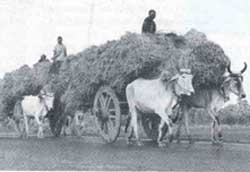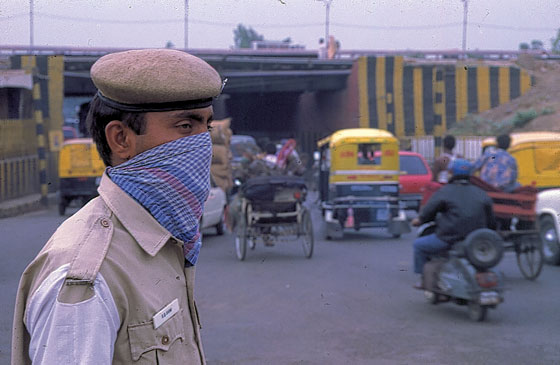
Beating about the bush
Many important issues were hardly touched upon at the recently concluded conference on bioresources

Many important issues were hardly touched upon at the recently concluded conference on bioresources

Authorities tread on slippery ground trying to resolve the fuel crisis in Mysore
THE ministry of non-conventional energy sources (MNES) is giving the rich city dweller in the country an optional source of electricity: rooftop photovoltaic cell units which convert sun rays into

Whether it"s increasing yields, cutting growth time of plants, increasing their resistance to disease or preserving genetic resources, scientists say tissue culture could be an important answer to farmers" prayers. Small wonder then that industry, with it

Some now ways of using fortilisers which will prevent nitrogen seepage into the water table

the Union government increased the minimum support price of wheat, paddy, sugarcane, mustard, rapeseed and other agricultural commodities on October 9. The announcement was made after the Cabinet
Prasenjit Bose Since the Finance Minister would not have the opportunity to present a full Budget in 2009 because of impending Lok Sabha elections, Budget 2008-09 would be his last opportunity to fulfil the promises made in the National Common Minimum Programme (NCMP). The expenditure priorities have already been set forth by the Eleventh Plan. What is required is adequate budgetary support for the Plan, especially in priority areas like agriculture, PDS, education, health and employment generation. To meet the NCMP commitments, the gross budgetary support (GBS) for the Plan has to be stepped up. Budgets in 2006 and 2007 witnessed increases in GBS by around Rs 30,000 crore over previous years. It is evident that an increase of such magnitude, which amounts to less than 1% of current GDP, is inadequate for vital expenditure commitments. The increase in the GBS should be twice the amount seen in recent budgets. Agriculture, which was promised a new deal under the UPA, continues to languish. The advanced estimates for 2007-08 already show agricultural growth slipping to 2.6%, compared to 3.4% registered in 2006-07. To meet the Eleventh Plan target of 4% agriculture growth rate, the government needs to replace the half-hearted measures adopted so far with substantial allocations for debt relief, the Food Security Mission and Rashtriya Krishi Vikas Yojana. The rise in prices of essential commodities over the last two years has underlined the importance of strengthening the PDS. Domestic food production and public procurement also needs to increase to avoid the embarrassment of high-cost wheat imports. India should increase the food subsidy, which currently stands only at around 1% of GDP. It is also time to consider doing away with the targeted PDS, which has turned out to be a failure, and introduce a revamped, more efficient and universal PDS. The ban on futures trading of wheat, rice and some pulses imposed last year should continue for the sake of stability in food prices. Education and health have been accorded high priority under the Eleventh Plan. Expenditure on the former, up five-fold over the Tenth Plan, is aimed at building 6,000 schools, funding the Sarva Shiksha Abhiyan to ensure the Right to Education, building new ITIs and vocational training institutes to bridge the skill deficit, and setting up 30 new central universities along with new IITs, IIMs and IISERs to expand the country's knowledge base. These laudable objectives have to be backed up by adequate outlays. Outlays on the rural health mission and more Aiims-type institutions also have to be increased. The universalisation of the ICDS is being impeded by inadequate funding, which needs to be addressed. The NREGA, despite problems, has succeeded in providing work to 27.7 million people this year. No doubt, its implementation needs to be streamlined and the monitoring mechanism improved. However, this should not come in the way of expanding the employment guarantee to all rural districts and also to urban areas. This is the single biggest welfare measure adopted by the UPA government, and has offered relief to the poorest and most vulnerable. This safety net must be strengthened under all circumstances. The revenue buoyancy seen over the past few years should help mobilise resources for increased welfare expenditure and public investments. Efforts to widen the tax base should continue. The last Budget contained a study of corporate tax, which showed that the effective tax rate for Companies in 2006-07 was 19.2% against the scheduled tax rate of 33.6%. Tax concessions to corporate taxpayers increased from Rs 34,618 crore in 2005-06 to Rs 50,075 crore in 2006-07. Budget 2008-09 should take steps to bring down these tax expenditures. The burgeoning foreign exchange reserves built up on the basis of FII inflows have turned into a liability. Rupee appreciation is hurting export sectors and efforts to buy up foreign exchange followed by sterilisation are also leading to additional fiscal costs. Reintroduction of long-term capital gains tax and increasing the rate of the short-term capital gains tax and the STT would help stanch the inflow of speculative capital, curb equity market volatility and raise resources. Budget 2008 also offers the opportunity to initiate the long pending restructuring of the indirect tax structure on petroleum products
The broad terms of the draft agreement expected to be ratified in August by countries participating in the 6th session of the United Nations Conference on Straddling Fish Stocks and Highly Migratory
Only a very small section of the country s urban population benefits from sewerage systems and this section consists of the richest urban people

Union budget 2002 03: all the right noises, all the wrong measures

<p>Centre for Science and Environment (CSE) has welcomed today’s Supreme Court decision on checking air pollution in the NCR. The Court today has admitted the report from the Environment Pollution (Prevention and Control) Authority (EPCA) on ‘Priority measures to reduce air pollution and protect public health’ as an interlocutory application (IA).</p>
The Impact On Urban Transportation By TATHAGATA CHATTERJI Thousands of sleek, little Tata-Nanos are likely to jostle for urban road space within a year. Nano boasts a brilliant design innovation for the all-weather travel requirements of the budget-conscious Indian family. However, the very affordability of the car has raised certain critical questions: If the roads are clogged by millions of new cars, will there be enough space to drive? How does one manage the legitimate aspirations of the Indian family in the urban context? The future of mobility in Indian cities, already teeming with bumper to bumper traffic and exasperated commuters, needs urgently to be addressed as the country moves towards an increasingly urban future along with the structural shift in the economy ~ from agriculture to industry and service. With 285 million people, urban India now accounts for 28 per cent of the country's population, 62 per cent of the GDP and the bulk of the car purchases. Between 1981 and 2001, on an average, the population in the six metro cities increased by 1.8 times but the number of vehicles rose six-fold. In the Delhi-NCR area, 420 million man-hours are lost every month because of traffic congestion, according to ASSOCHAM. With 1,421 cars per square kilometer, Kolkata now has a higher car density than the vastly more affluent Berlin. There has been a spatial shift as well with the IT and the IT-enabled sector emerging as the main factors of the urban economy and frequently locating to self-contained business complexes in the fringe areas of big cities. Such sleepy residential suburbs of the eighties as Gurgaon, NOIDA or Salt Lake, have now overtaken traditional business areas like Connaught Place or Dalhousie Square as corporate destinations of choice. This combined effect of "suburbanization' of the urban economy and the rising road congestion had compelled the state governments to construct highways and flyovers, replicating the American urban model of car dependent, low-density garden suburbs of the 1950s. However, as the Americans found out the hard way, by the 1970s, the ever-increasing freeways resulted in increased use of cars. This led to rising energy cost, pollution and travel time. Delhi is witness to a similar phenomenon today. Amongst the Indian cities, Delhi has the most extensive roadspace along with an elaborate programme of flyover construction. Over the past 10 years, road length increased by 20 per cent, but cars increased by 132 per cent. The ambitious Delhi-Gurgaon Expressway appears to have crossed the carrying capacity estimated for the year 2016 by the time it was inaugurated this year. The 32-lane toll plaza ~ supposedly the largest in Asia ~ has earned the sobriquet, "parking plaza'. Elsewhere, traffic moves fast on the flyovers but gets stuck in bottlenecks down the road. Compare this with New York, London, Paris or Singapore ~ the high temples of international finance ~ cities where people get around on foot, by taxi or via mass transit. Zurich, Melbourne, Copenhagen ~ which frequently tops the urban quality of living index ~ a sort of ATP ranking of the cities, have a dense urban core, pedestrian-friendly streets, a network of high quality mass transit and policies which discourage private cars in core areas. In parts of Tokyo, one cannot own a car unless one owns a private parking space. London introduced congestion charges in city centre areas in 2003. Since then the volume of traffic has been reduced by 21 per cent and delays shortened by two minutes per kilometer. The present gridlocked mess in India is the outcome of short sighted and uncoordinated policies on land use and transportation. According to a Centre for Science & Environment study, a bus carrying 40 passengers occupies about 2.5 times the roadspace than a car with one or two persons and, at the same time, pays 2.6 times higher tax as well. So the poor end up paying in terms of higher travel time and cost. The real estate costs are sky-high but a single parking slot that occupies 23 square metres costs only Rs 10 for a day, whereas a shop or desk space are charged full commercial rates. Diesel subsidies meant for the trucks and buses are gobbled up by chauffer-driven limousines. Public transport is chronically mismanaged and inadequate. The term

Balotra, an arid little town in Rajasthan, has a novel way of raising money to treat effluents from its mushrooming textile dyeing and processing industry.
Many natural resources are consistently overused and undervalued by modern Indian industry; none more so than water. Factories and manufacturing centres throughout the country have a carte blanche
The World Bank, admitting the competition between food and fuel crops for land and water, has asked the national governments to carefully assess economic, environmental, and social benefits and the potential to enhance energy security. In its World Development Report-2008, it said: "The challenge for developing country governments is to avoid supporting bio-fuels through distortionary incentives that might displace alternative activities with higher returns - and to implement regulations and devise certification system to reduce environmental risks.' It suggested that the potential environmental risks from large scale bio-fuels production can be reduced through certification schemes for measuring environmentalaspects. It suggested a Green Bio-fuels Index of GHG reductions. The World Bank quoted that according to some available estimates, current bio-fuel polices the world over, can lead to a five-fold increase of the share of bio-fuels in global transport energy consumption - from 1% today to around 5% to 6% by 2020. "The grain required to fill the tank of a Sports utility vehicle with ethanol (240 kg of maize for 100 litre ethanol) could feed one person for a year, so competition between food and fuel is real,' the World Bank report said. It added that future bio-fuel technology may rely on dedicated energy crops and agricultural and timber wastes instead of food crops. "Technology to break cellulose into sugars distilled to produce ethanol or gasify biomass is not yet commercially viable - and will not be for several years. And some competition for land and water between dedicated energy crops and food crops will likely remain,' the report said. It further said that second generation bio-fuels using cellulosic technologies were likely to require even larger economies of scale, with investment costs in hundreds of millions of dollars just to build one plant. The report admitted that in industrial countries and till recently in Brazil, bio-fuel programmes were supported by high protective tariffs and large subsidies. These policies have caused land conversion away from food and led to an upward pressure on global food prices, severely affecting poor consumers. With a view to make bio-fuels compete with gasoline, industrial countries gave massive support and subsidies. According to recent estimates, more than 200 support measures costing around $5.5-7.3 billion a year in the US amount to $0.38-0.49 per litre of petroleum equivalent for ethanol and $0.45-0.57 for bio-diesel. In this context, the World Bank report questions - Are bio-fuels economically viable without subsidies and protection? It answers: "The breakeven price for a given bio-fuel to become economical is a function of several parameters. The most important determining factors are the cost of oil and the cost of the feedstock, which constitute more than half of today's production costs. Other often more cost-effective ways of delivering environmental and social benefits need to be considered, especially through improvements in fuel efficiency.

In the past five years, when cotton farmers of Maharashtra, Andhra Pradesh and Punjab were struggling, Gujarat farmers were making hay, to the tune of Rs 5,000 crore a year. The state’s total yield has increased by 5.6 million bales in the past five years.

Pushed out by salt
Get eight economists to discuss an issue and you"ll get nine opinions. Down to Earth did precisely that. Eight noted economists were invited, along with a scientist-activist, an industrialist, a bureaucrat and two educationists, to analyse the impact
granny often knows best. Whenever there was a sore throat or a toothache we went to her and grandma obligingly pulled out a potion from her treasure trove of remedies. Many of them even worked.

The government's employment generation schemes, laudable though they may be, have yet to achieve their goals. Not involving intended beneficiaries is cited as a major reason for their failure.